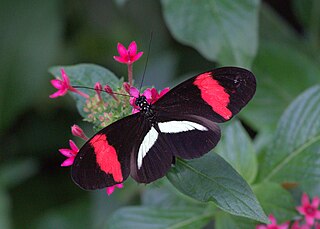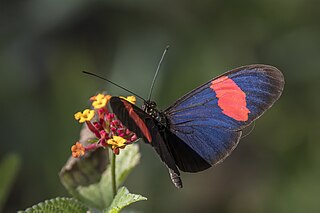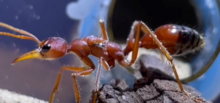
In evolutionary biology, mimicry is an evolved resemblance between an organism and another object, often an organism of another species. Mimicry may evolve between different species, or between individuals of the same species. In the simplest case, as in Batesian mimicry, a mimic resembles a model, so as to deceive a dupe, all three being of different species. A Batesian mimic, such as a hoverfly, is harmless, while its model, such as a wasp, is harmful, and is avoided by the dupe, such as an insect-eating bird. Birds hunt by sight, so the mimicry in that case is visual, but in other cases mimicry may make use of any of the senses. Most types of mimicry, including Batesian, are deceptive, as the mimics are not harmful, but Müllerian mimicry, where different harmful species resemble each other, is honest, as when species of wasps and of bees all have genuinely aposematic warning coloration. More complex types may be bipolar, involving only two species, such as when the model and the dupe are the same; this occurs for example in aggressive mimicry, where a predator in wolf-in-sheep's-clothing style resembles its prey, allowing it to hunt undetected. Mimicry is not limited to animals; in Pouyannian mimicry, an orchid flower is the mimic, resembling a female bee, its model; the dupe is the male bee of the same species, which tries to copulate with the flower, enabling it to transfer pollen, so the mimicry is again bipolar. In automimicry, another bipolar system, model and mimic are the same, as when blue lycaenid butterflies have 'tails' or eyespots on their wings that mimic their own heads, misdirecting predator dupes to strike harmlessly. Many other types of mimicry exist.

The large blue is a species of butterfly in the family Lycaenidae. The species was first defined in 1758 and first recorded in Britain in 1795. In 1979 the species became mostly extinct in Britain but has been successfully reintroduced with new conservation methods. The species is classified as "near threatened" on the IUCN Red List of Threatened Species. Today P. arion can be found in Europe, the Caucasus, Armenia, western Siberia, Altai, north-western Kazakhstan and Sichuan.

Batesian mimicry is a form of mimicry where a harmless species has evolved to imitate the warning signals of a harmful species directed at a predator of them both. It is named after the English naturalist Henry Walter Bates, who worked on butterflies in the rainforests of Brazil.

The viceroy is a North American butterfly. It was long thought to be a Batesian mimic of the monarch butterfly, but since the viceroy is also distasteful to predators, it is now considered a Müllerian mimic instead.

Heliconius charithonia, the zebra longwing or zebra heliconian, is a species of butterfly belonging to the subfamily Heliconiinae of the family Nymphalidae. It was first described by Carl Linnaeus in his 1767 12th edition of Systema Naturae. The boldly striped black and white wing pattern is aposematic, warning off predators. It is the state butterfly of Florida.

Müllerian mimicry is a natural phenomenon in which two or more well-defended species, often foul-tasting and sharing common predators, have come to mimic each other's honest warning signals, to their mutual benefit. The benefit to Müllerian mimics is that predators only need one unpleasant encounter with one member of a set of Müllerian mimics, and thereafter avoid all similar coloration, whether or not it belongs to the same species as the initial encounter. It is named after the German naturalist Fritz Müller, who first proposed the concept in 1878, supporting his theory with the first mathematical model of frequency-dependent selection, one of the first such models anywhere in biology.

Heliconius erato, or the red postman, is one of about 40 neotropical species of butterfly belonging to the genus Heliconius. It is also commonly known as the small postman, the red passion flower butterfly, or the crimson-patched longwing. It was described by Carl Linnaeus in his 1758 10th edition of Systema Naturae.

Heliconius cydno, the cydno longwing, is a nymphalid butterfly that ranges from Mexico to northern South America. It is typically found in the forest understory and deposits its eggs on a variety of plants of the genus Passiflora. It is a member of the Heliconiinae subfamily of Central and South America, and it is the only heliconiine that can be considered oligophagous. H. cydno is also characterized by hybridization and Müllerian mimicry. Wing coloration plays a key role in mate choice and has further implications in regards to sympatric speciation. Macrolide scent gland extracts and wing-clicking behavior further characterize this species.

Ant mimicry or myrmecomorphy is mimicry of ants by other organisms; it has evolved over 70 times. Ants are abundant all over the world, and potential predators that rely on vision to identify their prey, such as birds and wasps, normally avoid them, because they are either unpalatable or aggressive. Some arthropods mimic ants to escape predation, while some predators of ants, especially spiders, mimic them anatomically and behaviourally in aggressive mimicry. Ant mimicry has existed almost as long as ants themselves; the earliest ant mimics in the fossil record appear in the mid-Cretaceous alongside the earliest ants.

Heliconius comprises a colorful and widespread genus of brush-footed butterflies commonly known as the longwings or heliconians. This genus is distributed throughout the tropical and subtropical regions of the New World, from South America as far north as the southern United States. The larvae of these butterflies eat passion flower vines (Passifloraceae). Adults exhibit bright wing color patterns which signal their distastefulness to potential predators.

Heliconius melpomene, the postman butterfly, common postman or simply postman, is a brightly colored, geographically variable butterfly species found throughout Central and South America. It was first described by Carl Linnaeus in his 1758 10th edition of Systema Naturae. Its coloration coevolved with another member of the genus, H. erato as a warning to predators of its inedibility; this is an example of Müllerian mimicry. H. melpomene was one of the first butterfly species observed to forage for pollen, a behavior that is common in other insect groups but rare in butterflies. Because of the recent rapid evolutionary radiation of the genus Heliconius and overlapping of its habitat with other related species, H. melpomene has been the subject of extensive study on speciation and hybridization. These hybrids tend to have low fitness as they look different from the original species and no longer exhibit Müllerian mimicry.

Aggressive mimicry is a form of mimicry in which predators, parasites, or parasitoids share similar signals, using a harmless model, allowing them to avoid being correctly identified by their prey or host. Zoologists have repeatedly compared this strategy to a wolf in sheep's clothing. In its broadest sense, aggressive mimicry could include various types of exploitation, as when an orchid exploits a male insect by mimicking a sexually receptive female, but will here be restricted to forms of exploitation involving feeding. For example, indigenous Australians who dress up as and imitate kangaroos when hunting would not be considered aggressive mimics, nor would a human angler, though they are undoubtedly practising self-decoration camouflage. Treated separately is molecular mimicry, which shares some similarity; for instance a virus may mimic the molecular properties of its host, allowing it access to its cells. An alternative term, Peckhamian mimicry, has been suggested, but it is seldom used.

Emsleyan mimicry, also called Mertensian mimicry, describes an unusual type of mimicry where a deadly prey mimics a less dangerous species.

Heliconius ismenius, the Ismenius tiger or tiger heliconian, is a butterfly of the family Nymphalidae found in Central America and northern South America. They are abundant as far south as Ecuador and Venezuela and as far north as southern Mexico, Guatemala and Belize. H. ismenius are more commonly called the tiger-striped long wing butterfly. H. ismenius's nickname is derived from its long wing structure as well as the beautiful burnt orange and black stripes. Pierre André Latreille, a French zoologist, described Heliconius ismenius in 1817. H. ismenius resembles a number of other butterflies, an example of Müllerian mimicry.

Chemical mimicry is a type of biological mimicry involving the use of chemicals to dupe an operator.

In evolutionary biology, mimicry in plants is where a plant evolves to resemble another organism physically or chemically. Mimicry in plants has been studied far less than mimicry in animals. It may provide protection against herbivory, or may deceptively encourage mutualists, like pollinators, to provide a service without offering a reward in return.
Locomotor mimicry is a subtype of Batesian mimicry in which animals avoid predation by mimicking the movements of another species phylogenetically separated. This can be in the form of mimicking a less desirable species or by mimicking the predator itself. Animals can show similarity in swimming, walking, or flying of their model animals.
In evolutionary biology, mimicry in vertebrates is mimicry by a vertebrate of some model, deceiving some other animal, the dupe. Mimicry differs from camouflage as it is meant to be seen, while animals use camouflage to remain hidden. Visual, olfactory, auditory, biochemical, and behavioral modalities of mimicry have been documented in vertebrates.

Chemical communication in insects is social signalling between insects of the same or different species, using chemicals. These chemicals may be volatile, to be detected at a distance by other insects' sense of smell, or non-volatile, to be detected on an insect's cuticle by other insects' sense of taste. Many of these chemicals are pheromones, acting like hormones outside the body.

Lawrence E. Gilbert is an American biologist, known for his discovery of Gilbertian mimicry.

















